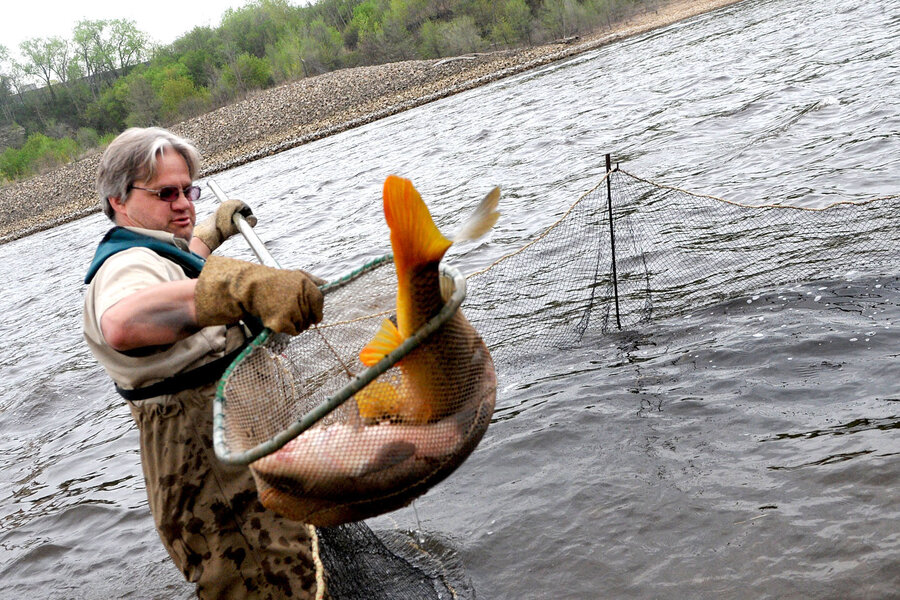Lake Erie Asian carp: How great a threat to Great Lakes?
Loading...
Given a fin-hold in the Great Lakes, Asian carp would probably become the most common catch in fish-rich Lake Erie.
Concerns that the invasive Asian carp species could move from the Mississippi River into the Great Lakes are hardly new, but a study released Monday used a computer model to predict that Asian carp could become as much as one-third of Lake Erie's total fish population, to the detriment of some lake natives, including walleye, gizzard shad, and emerald shiners.
"It's very sobering," Marc Gaden, spokesman for the Great Lakes Fishery Commission told the Associated Press. "Lake Erie is one of the most productive inland fisheries in the world. It wouldn't be as valuable by any stretch of the imagination if one out of every three pounds of fish were Asian carp."
While there is no evidence that a significant population of the fish have crossed the electric fences into Lake Erie yet, the carp have had those involved with the $7-billion Great Lakes fishing industry nervous for years, The Christian Science Monitor reported in November:
Asian carp – a term that encompasses the Bighead, Black, Grass and Silver carp – pose a danger because of their effects on native species. Competition over food can wreak havoc on an ecosystem. The carp can grow up to seven feet and 110 pounds, eating up to 20 percent of its body weight each day... Asian carp were first introduced in the 1970s to the United States, brought in to filter algae out of catfish ponds on Arkansas fish farms. By the 1990s, they had become a scourge, spreading through much of the Mississippi River watershed and beyond.
Once they reached Lake Erie, the study suggests the Asian carp would eat other fish and, although a few native species could benefit, the projection increases the urgency of creating a barrier between carp and the Great Lakes.
A 2014 report commissioned by Congress offered eight possible strategies to keep the carp out of Lake Erie, including screened gates, locks, and physical barriers, Mark Guarino reported for The Christian Science Monitor. A full physical separation would cost an estimated $18 billion, but the Corps also suggested a plan to net and poison the fish for $68 million.
The Obama administration answered a call to action from Great Lakes politicians with a $200 million investment for studies and work mostly around a Chicago canal, and three electric fences currently keep the fish at bay. Implementing the strategies from the Corps, however, would require Congressional action and probably begin in 2017 at the earliest, The Monitor reported.
Several companies have already begun an entrepreneurial response. One of these, the Kentucky-based Two Rivers Fisheries, aims to catch the carp Americans don't want and send them back to Asia – on a silver platter.
Angie Wu, the company's founder, read an article calling the proliferation of carp a "disaster" in 2010, Arian Campo-Flores reported for The Wall Street Journal. She said she considers the Asian carp delicious, as do most Chinese, and in 2013 her company began catching and shipping what she is marketing as the tasty "Kentucky white fish" to China.
Jeff Smith, the company's operations manager, tells The Christian Science Monitor the company's harvest is currently limited by the abundance of fishermen, not fish.
"There's just not enough fishermen to take care of what I need," says Mr. Smith.
Two River Fisheries came close to doubling the number of containers shipped out in its first two years and brings in 12,000-15,000 fish daily, weather permitting.








